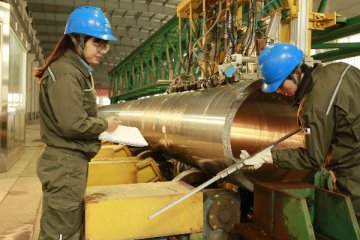The iron ore industry saw a marked recovery in 2016 after the slower growth, lower prices and squeezed profit margins suffered in 2015, a report by the United Nations Conference on Trade and Development (UNCTAD) showed on Monday.
According to the report, a late surge enabled the iron ore industry to post gains in both production and exports in 2016, despite soft Chinese consumption and low prices during the year.
The resurgence came in a year when concerns about a range of anti-dumping actions taken by the World Trade Organization (WTO) members on imported steel dominated discussions.
The UNCTAD report, however, shows the key indicators of demand and supply, seaborne trade and price, all made gains through the year and it says the market outlook is steady.
"The market for base metals such as iron ore is a yardstick for the global economy, and in recent years it has fluctuated closely with the state of emerging and developing countries' economies," said Yanchun Zhang, Chief of UNCTAD's Commodity Policy Implementation and Outreach Section.
Although Chinese consumption remained relatively low, and prices did not improve for much of 2016, the market started to improve late in the year with prices exceeding 80 U.S. dollars per dry metric ton (dmt) in December 2016.
Global iron ore production grew 5 percent year-on-year in 2016, according to the report, hitting 2,106 million tons (Mt).
This was primarily driven by an additional 30 Mt of direct shipping ore from Australia, which was the major source of new fine-products entering the Chinese market.
Iron ore exports exceeded 1,500 Mt in 2016 compared with about 1,439 Mt in 2015, and the seaborne market was more or less balanced.
The net increase in global trade was also led by Australia.
Producers of iron ore have reduced mining costs substantially over the past four years, says the report, and the mining industry as a whole now spends 22 U.S. dollars/dmt, which is also less than it was in 2013.
That is due to tightened capital controls, renegotiated contracts and the exit of high cost supply says the report.
Iron ore exploration budgets fell in 2016 for the fourth straight year, with the estimated 685 million dollars expenditure representing a decline of 460 million dollars from the preceding year.
The UNCTAD report attributed most of the fall to Australia and China, which together accounted for almost half of the global decline.
According to the report, a late surge enabled the iron ore industry to post gains in both production and exports in 2016, despite soft Chinese consumption and low prices during the year.
The resurgence came in a year when concerns about a range of anti-dumping actions taken by the World Trade Organization (WTO) members on imported steel dominated discussions.
The UNCTAD report, however, shows the key indicators of demand and supply, seaborne trade and price, all made gains through the year and it says the market outlook is steady.
"The market for base metals such as iron ore is a yardstick for the global economy, and in recent years it has fluctuated closely with the state of emerging and developing countries' economies," said Yanchun Zhang, Chief of UNCTAD's Commodity Policy Implementation and Outreach Section.
Although Chinese consumption remained relatively low, and prices did not improve for much of 2016, the market started to improve late in the year with prices exceeding 80 U.S. dollars per dry metric ton (dmt) in December 2016.
Global iron ore production grew 5 percent year-on-year in 2016, according to the report, hitting 2,106 million tons (Mt).
This was primarily driven by an additional 30 Mt of direct shipping ore from Australia, which was the major source of new fine-products entering the Chinese market.
Iron ore exports exceeded 1,500 Mt in 2016 compared with about 1,439 Mt in 2015, and the seaborne market was more or less balanced.
The net increase in global trade was also led by Australia.
Producers of iron ore have reduced mining costs substantially over the past four years, says the report, and the mining industry as a whole now spends 22 U.S. dollars/dmt, which is also less than it was in 2013.
That is due to tightened capital controls, renegotiated contracts and the exit of high cost supply says the report.
Iron ore exploration budgets fell in 2016 for the fourth straight year, with the estimated 685 million dollars expenditure representing a decline of 460 million dollars from the preceding year.
The UNCTAD report attributed most of the fall to Australia and China, which together accounted for almost half of the global decline.




















Latest comments